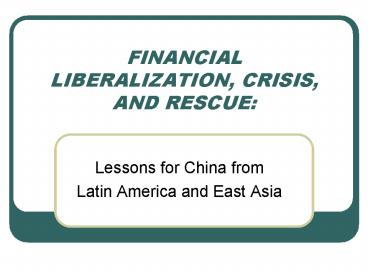FINANCIAL LIBERALIZATION, CRISIS, AND RESCUE: - PowerPoint PPT Presentation
1 / 21
Title:
FINANCIAL LIBERALIZATION, CRISIS, AND RESCUE:
Description:
Strengthened role of private sector and market forces in decision making ... Costs of crises linger for years -- Slower GDP growth -- Lower investment ratios ... – PowerPoint PPT presentation
Number of Views:212
Avg rating:3.0/5.0
Title: FINANCIAL LIBERALIZATION, CRISIS, AND RESCUE:
1
FINANCIAL LIBERALIZATION, CRISIS, AND RESCUE
- Lessons for China from
- Latin America and East Asia
2
Aims of Presentation
- Introduction
- Challenges facing Chinas financial sector
- Financial liberalization trends LA and EA
- Liberalization and crisis
- Rescue costs
- Lessons for China
3
Introduction
- Liberalization has transformed financial system
in developing countries - -- Strengthened role of private sector and
market forces in decision making - -- Resulted in crises and need for rescues
- -- Created new government role and increased
foreign ownership
4
Chinas Financial Sector
- Peoples Bank of China
- Policy banks
- State-owned commercial banks (Big 4)
- Publicly-listed commercial banks
- Non-bank financial institutions
- Securities markets
5
Chinas Successes
- Rapid growth over several decades
- Strong external accounts, including large volume
of reserves - Stability in face of Asian Crisis
6
Chinas Challenges
- Clean up NPLs and raise capital ratios in banking
sector - Improve regulation and supervision, corporate
governance - Continue liberalization of financial sector
(domestic and international) without crisis
7
Financial Liberalization Trends
- Definition of liberalization, WB Index
- Almost all countries have liberalized domestic
financial sector - LA has been eager, but volatile
- EA has moved more gradually
8
(No Transcript)
9
Policies Accompanying Liberalization
- Macroeconomic management
- Prudential regulation and supervision
- Capital account opening
- Institutional development
10
Liberalization and Crisis (1)
- Theoretical insights in recent literature
- -- New explanations for crises (internal
oriented, external oriented) - -- Twin crises
- -- Correlation between liberalization and twin
crises
11
Liberalization and Crisis (2)
- Twin crises in LA and EA (Chile, Mexico,
Argentina Thailand, Korea, Malaysia, Indonesia) - Typical syndrome
- -- Liberalization and privatization
- -- Lending boom, ignoring loan quality
- -- Macroeconomic policies leading to capital
inflows, overvaluation, debt build-up - -- Twin crisis
12
Liberalization and Crisis (3)
- Not all countries have suffered twin crises
- -- Governments took early measures (Brazil,
Philippines) - -- Countries received less private capital
inflows (Peru, Philippines) - -- Other types of crisis (Colombia, Venezuela,
Taiwan)
13
Rescue (1)
- Four rescue mechanisms commonly used
- -- Assistance to increase liquidity
- -- Assistance to raise capital ratios
- -- Removal of bad loans
- -- Take-over or closing of banks
- Details matter for outcomes
14
Rescue (2)
- Crises and rescues are very costly
- -- Fiscal outlays are high
- -- GDP losses are steep
- -- Other costs add to burden
15
(No Transcript)
16
Rescue (3)
- Costs of crises linger for years
- -- Slower GDP growth
- -- Lower investment ratios
- -- Lack of credit availability
17
(No Transcript)
18
Lessons for China (1)
- Gradual domestic liberalization preferable
- -- Importance not clear in LA and EA, but
Chinese banks lack experience - -- Clean up NPLs, increase capital ratios
- -- Generally improve capacity of financial
institutions to meet new challenges before full
liberalization
19
Lessons for China (2)
- Policies accompanying liberalization must be
selected with care - -- Real macro stability before liberalization
- -- Strong prudential regulation and supervision
before liberalization - -- Partial capital account opening after
liberalization and adjustment
20
Lessons for China (3)
- Institutions must be strengthened to support
liberalized system - -- Rule of law, judicial system
- -- Ministry of finance, central bank, regulatory
agencies, credit bureaus - Improving institutions takes time, furthering
argument for gradual approach
21
Conclusions
- China has opted for a market economy
- Financial sector is a crucial component
- May be some role for public-sector banks
- But main component of financial sector must be
autonomous banks that operate in stable,
self-sustaining manner































